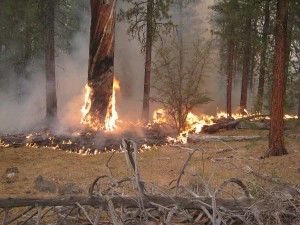
Fall 2015 Leaflet
SCIENCE
The Value of Fire: Restoring a More Natural Fire Regime
NATURAL FORESTS ARE MORE LIKELY TO SURVIVE DROUGHT AND MITIGATE CLIMATE CHANGE
The following is a summary of research conducted by Malcolm North, Research Forest Ecologist for the USDA Forest Service, to identify the effects of wildfire and drought dynamics on the carbon stores of fire-suppressed forests.
With climate change, high-intensity fires and drought are increasing in frequency and severity in many western forests. Widespread fire suppression and extensive forest thinning—both the result of human policies and management—have changed forest structure and composition, exacerbating this trend. The resulting forests are more susceptible to early tree death and have a reduced ability to mitigate climate change through sequestration and long-term carbon storage.
Forests are the most expandable terrestrial carbon sinks. In addition to efforts to increase carbon stores through reforestation and reducing deforestation, improving forest management to promote restoration of older, more natural forests can lead to greater net carbon stores—as well as more resilient forests. Policies and markets can influence this outcome. A key factor in achieving this is an improved understanding of the role fire plays in forests.
Historically, 26% of temperate forests were naturally shaped by fire, leading to more open forests with more large, older trees and fewer small, young trees. Forest management removed those large trees for timber, emphasized dense replanting, and sought to eliminate fire—especially in the past 75-100 years. This led to degraded forests with an over-abundance of smaller, fire-prone trees and a lack of larger, fire-resistant trees.

Lower intensity burn in a mixed conifer forest. Historically, many forests were managed by eliminating fire and harvesting large, valuable trees. This shifted the structure and composition of dry forests from low densities of large fire-resistant species to high densities of fire-sensitive species, which are prone to drought stress and fire-induced mortality.
To identify the effects of wildfire and drought on fire-suppressed forests’ ability to mitigate climate change, researchers compared two common, mixed-conifer forest types where fire was suppressed and where fire regimes were restored. Using computer models, researchers did hundreds of simulations using likely drought and fire scenarios that could occur over the next 300 years.
While fire-suppressed forest stands initially contained more live and dead wood, and thus, more stored carbon, they were less stable over time as drought and wildfire frequency increased due to their high abundance of smaller, fire-prone trees. Modeling confirmed that continued fire suppression in mixed-conifer forests resulted in forests that were less resilient and tolerant of disturbances.
By managing forests with active, low-intensity fires and selective fuels reduction, the models showed we can restore forest conditions that are tolerant of fire and drought, and provide more stable, dependable carbon sinks as changing climate conditions increase disturbance frequency.
Wildfire and drought dynamics destabilize carbon stores of fire-suppressed forests, Ecological Applications (2014), Earles, J. Mason, Malcolm P. North, and Matthew D. Hurteau. Ecological Society of America (View)
